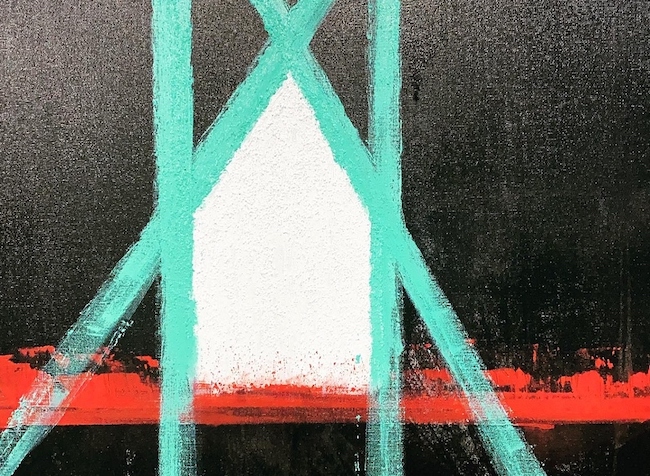Il fascino dell’indefinito spesso risiede esattamente nella sensazione di volerlo andare a scoprire, a determinare, per dargli un significato, un ordine logico che proprio attraverso la nebulosità trova il terreno migliore per chiarirsi e delinearsi; molti artisti vanno verso la direzione di meditare sui concetti del vivere contemporaneo mentre altri si lasciano invece andare alle sensazioni che fluiscono in maniera impulsiva perché fungono da valvola liberatoria per un’interiorità spesso senza voce. Il protagonista di oggi cerca una via intermedia, o per meglio dire esplora entrambe le modalità, quella più istintiva e quella più mentale, per raggiungere e spiegare quel senso che molto spesso sfugge proprio per il mistero che rappresenta.
Nel corso dell’arte del Novecento l’Astrattismo ha introdotto una nuova modalità espressiva, un linguaggio attraverso il quale i vari artisti aderenti alla corrente pittorica hanno sentito la necessità di distaccarsi dallo schema figurativo, quello che aveva dominato il panorama dei secoli precedenti, affermando la supremazia dell’atto creativo su qualsiasi altro mezzo di riproduzione dell’immagine e spesso su qualunque coinvolgimento emozionale; il Suprematismo Russo aveva cominciato a dare linee guida sull’utilizzo dei colori primari e della rappresentazione della realtà attraverso forme geometriche, linee guida che furono riprese ed estremizzate da Teo Van Doesburg e Piet Mondrian nel fondare il loro movimento De Stijl in cui tutto era razionalizzato fino a escludere persino la linea diagonale che avrebbe distolto dal rigore assoluto delle loro tele, distaccandosi così nettamente dall’Astrattismo Lirico di Vassily Kandinsky dove invece la mancanza di forma conosciuta era la base per la manifestazione emozionale. L’intento in quegli anni era quello di distogliere l’attenzione dalle devastazioni, dalle guerre, per dare agli artisti la possibilità di produrre opere di forte impatto e significato astraendosi da una contingenza che aveva provocato destabilizzazione, paure, angosce; nel proseguire dei decenni, dopo un passaggio in alcuni casi meno rigoroso, come per l’Astrattismo Geometrico che riaccolse anche forme precedentemente escluse e una gamma cromatica più ampia, in altri casi più estremo come per tutti i movimenti di annullamento della forma tra cui lo Spazialismo, si tornò alla precedente teoria di Kandinsky secondo la quale il gesto pittorico non può prescindere dall’emozione perché è attraverso di essa che il fruitore si lascia avvolgere da una tela. Il maggiore promotore di questo nuovo punto di vista sull’astrattismo fu Jackson Pollock che diede vita negli Stati Uniti al movimento dell’Espressionsimo Astratto, mescolando così la direzione completamente emozionale dell’Espressionismo alla libertà della non forma; era proprio questo il fulcro della corrente, quello della mancanza di una regola esecutiva che avrebbe ingabbiato la spontanea espressione di ciascun artista. Ecco dunque che all’Action Painting di Pollock si affiancò il Color Field di Mark Rothko in cui l’approccio più riflessivo infondeva nell’osservatore un fascino lirico e avvolgente che lo induceva a perdersi nelle sue grandi tele; l’interpretazione in Italia dell’Espressionismo Astratto si concretizzò con l’Arte Informale, meno impetuosa forse ma non per questo meno intensa, in cui all’impatto cromatico si andavano ad aggiungere materiali plastici, o scarti di lavorazioni industriali, legni, sacchi di juta, evolvendo così la ricerca pittorica verso una maggiore interazione con l’ambiente circostante la tela.
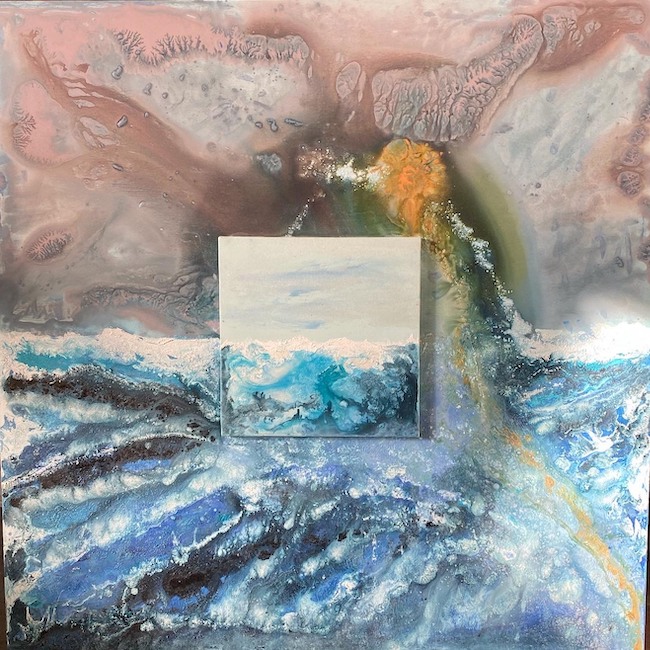
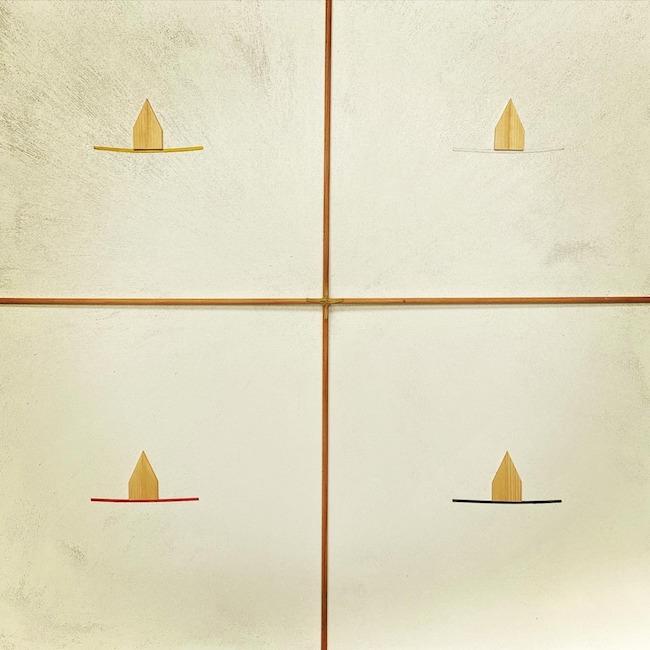
Il percorso artistico dell’artista piemontese Arp Verdeacqua, al secolo Alessandro Ramella Pralungo, si muove all’interno quel sottile confine tra impulso e logica, tra necessità di addentrarsi all’interno di un caos interiore, quello delle profondità che spesso si trascura di ascoltare, e l’esigenza di razionalizzare ciò che accade, le circostanze e gli eventi che generano quel concatenamento di causa ed effetto che, in fondo, determina le scelte e il cammino che ciascuno intraprende; non potrebbe esistere il desiderio di ordine se prima non si è passati attraverso il disordine, ed è esattamente il processo di presa di coscienza di se stessi e del proprio bisogno di sedersi e riflettere che conduce Arp Verdeacqua, tanto quanto l’osservatore delle sue opere, a prendere consapevolezza di essere l’unico padrone del proprio destino, persino quando gli accadimenti sembrano suggerire l’esatto opposto, cioè di sentirsi in balìa di una forza non governabile.
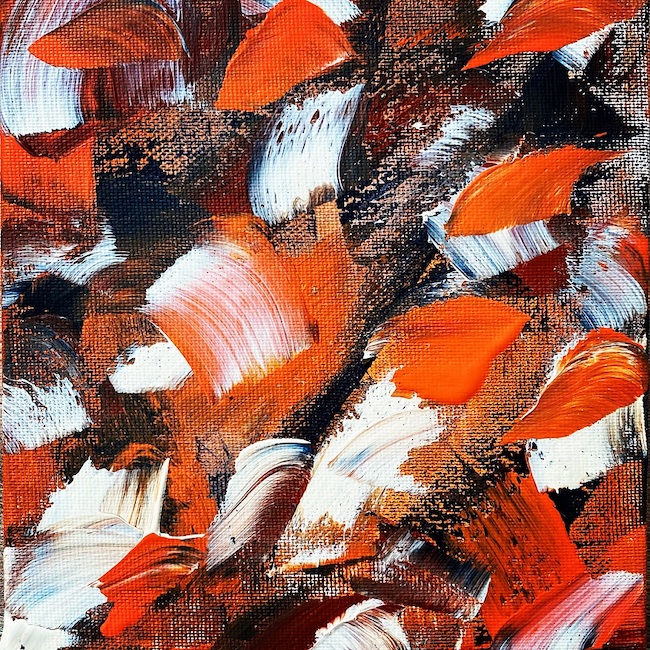
Le tonalità scelte dall’artista variano in base al concetto che desidera esprimere, tanto quanto cambiano gli stili pittorici, dunque parte dall’Espressionismo Astratto per raccontare quel caos istintivo che niente ha a che vedere con la ragione e dunque sceglie una pura visività la quale si lega all’istinto di non pensare, di lasciar fluire sensazioni senza senso apparente; a questa serie appartiene la tela Pensieri a pennello, in cui la gamma cromatica si accorda alla gioia creativa, a quella consapevolezza di appartenere all’universo privilegiato di chi è in grado di comunicare attraverso un gesto, quello segnico, che parla un linguaggio comprensibile a chiunque, senza distinzione linguistica, culturale, sociale.
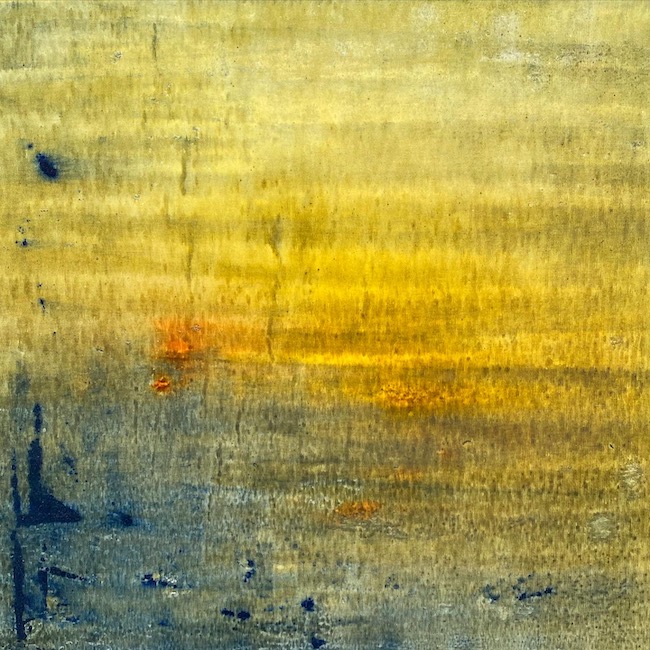
Ecco dunque che i colori sono vivi, predomina l’arancione che simboleggia proprio la creatività e l’armonia ma anche l’ambizione, quel desiderio di crescita, di espansione, che è innata in ogni artista. Nella serie Astrazioni il tratto diviene meno intenso, più sfumato, come se l’artista necessitasse compiere quei passi di ascolto che precedono la presa di coscienza, l’osservazione funzionale a scoprire, attraverso l’esterno, il proprio interno; la tela L’alba rappresenta quel particolare momento della giornata in cui la mente è aperta, in cui i sensi si sono appena risvegliati e l’incalzante ritmo quotidiano non è ancora cominciato dunque è possibile prendersi un attimo per riflettere, per osservare la meraviglia di una natura che, a sua volta, sta tornano alla luce dopo il buio della notte. L’Espressionismo Astratto tende quasi verso il Color Field in quest’opera dalla quale trapela un’intensa atmosfera magica che coinvolge proprio per il sottinteso invito alla meditazione. Il pentagono è uno dei tratti distintivi di Arp Verdeacqua, che lo ripropone anche nella serie Ascesa imperfetta in cui la sua pittura si fa più evanescente, meno incisiva nell’approccio alla tela ma ugualmente in grado di attrarre magneticamente lo sguardo dell’osservatore, in questo caso in virtù dell’indefinito, con quell’impalpabile atmosfera che induce alla riflessione, all’ascolto, come se l’immagine fosse avvolta da un riverente silenzio, come nell’opera La mia anima.
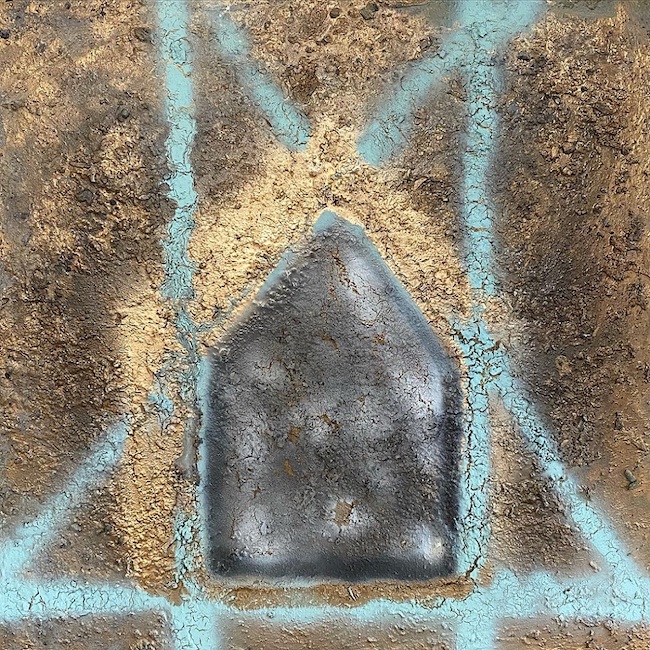
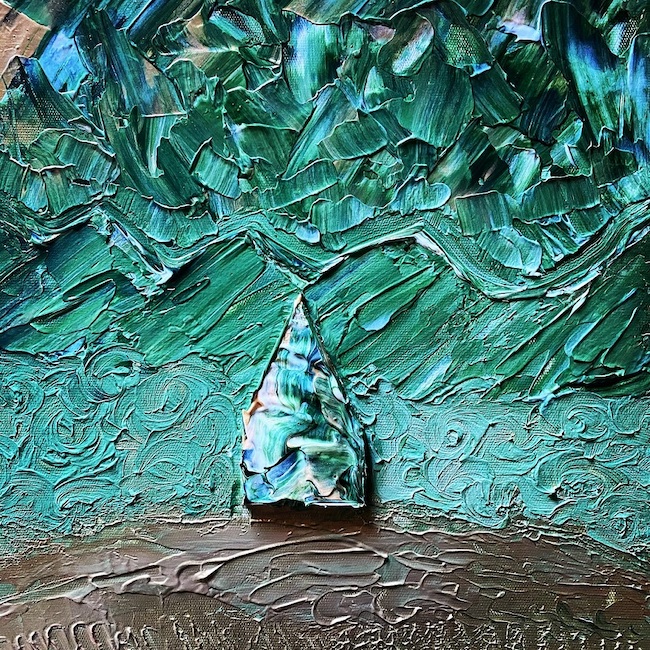
Qui la foglia oro è leggera, delicata, quasi un discreto sfondo necessario a sottolineare il tenue celeste che rappresenta quella luce interiore, quel sussurro dell’interiorità che desidera farsi ascoltare. Nella serie Soul, a cui appartiene l’opera La mia terra, Arp Verdeacqua si inoltra in un terreno più intimista, più orientato all’ascolto dell’esterno, di ciò che circonda il sé e che costituisce tutto ciò che spesso non viene osservato, che viene trascurato ma che in fondo è imprescindibile alla stessa esistenza; la sua terra può essere quella delle sue origini ma anche quella più generale, quella sfera terrestre generatrice di vita, attraverso le enormi distese di acqua che la rivestono, e che sa essere tanto impetuosa da toglierla quella stessa vita. L’essere umano è narrato dall’artista sotto forma di pentagono, quasi come se rappresentasse una casa, quel luogo all’interno del quale le persone si sentono al sicuro malgrado l’aspetto travolgente della natura circostante; la pittura è densa, materica, a sottolineare l’inconsistenza dell’esistenza di fronte al potere ingestibile del mondo che ospita l’essere umano.
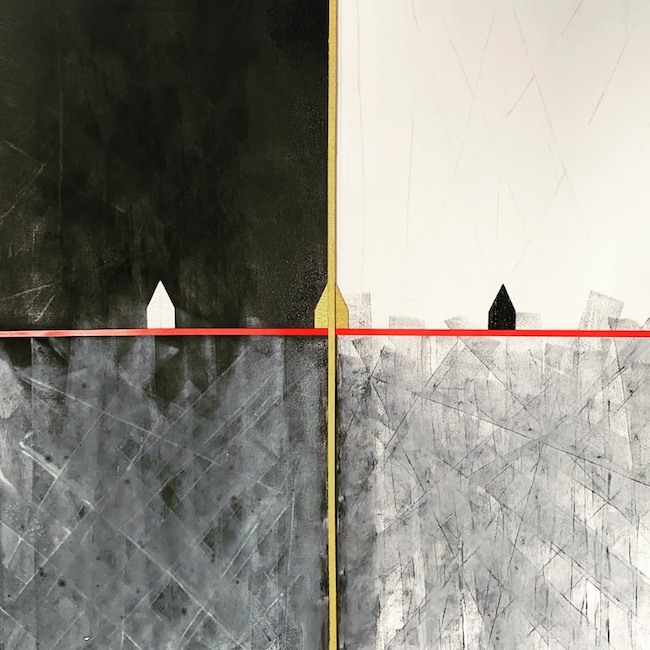
Nella tela Il nostro cammino però si sposta verso una maggiore geometricità, un rigore espressivo attraverso il quale intende esplorare il mistero dell’esistenza, quell’enigma che avvolge l’uomo contemporaneo ma a cui l’emotività spesso si sottrae per non ammettere di non avere risposte, di doversi a volte lasciar andare al corso della vita; i quattro riquadri dell’opera, in cui appaiono elementi materici e l’immancabile pentagono che costituisce il punto centrale della sua interrogazione esistenziale, rappresentano il susseguirsi della vita, di quel passaggio tra positivo e negativo, tra eventi gioiosi e altri tristi a cui l’uomo è sottoposto mentre tenta di rimanere in bilico al centro dei due, in quella linea dorata in cui trovare un equilibrio necessario a restare in piedi. Arp Verdeacqua ha scoperto tardivamente la sua vena artistica ma questo non gli ha impedito, in breve tempo, di essere notato da pubblico e addetti ai lavori.
ARP VERDEACQUA-CONTATTI
Email: info@arpverdeacqua.it
Sito web: https://arpverdeacqua.it/
Facebook: https://www.facebook.com/arp.verdeacqua.5
Instagram: https://www.instagram.com/arpverdeacqua/
The irresistible order of chaos in Arp Verdeacqua’s Informal Art
The fascination of the indefinite often lies precisely in the sensation of wanting to discover to determine it, to give it a meaning, a logical order that precisely through its vagueness finds the best terrain for clarifying and delineating itself; many artists move in the direction of meditating on the concepts of contemporary living, while others let themselves go to sensations that flow impulsively because it act as a liberating valve for an interiority that is often voiceless. Today’s protagonist seeks an intermediate way, or rather explores both modes, the more instinctive and the more mental, to reach and explain that sense which very often escapes precisely because of the mystery it represents.
In the course of twentieth-century art, Abstractionism introduced a new mode of expression, a language through which the various artists adhering to the pictorial current felt the need to break away from the figurative scheme that had dominated the panorama in previous centuries, asserting the supremacy of the creative act over any other means of reproducing the image and often over any emotional involvement; Russian Suprematism had begun to give guidelines on the use of primary colours and the representation of reality through geometric shapes, guidelines that were taken up and taken to extremes by Teo Van Doesburg and Piet Mondrian in founding their De Stijl movement in which everything was rationalised to the point of excluding even the diagonal line that would have distracted from the absolute rigour of their canvases, thus distancing themselves clearly from Vassily Kandinsky’s Lyrical Abstractionism where instead the lack of known form was the basis for emotional manifestation.
The intention in those years was to distract attention from the devastation and wars, to give artists the opportunity to produce artworks with a strong impact and meaning, abstracting themselves from a contingency that had caused destabilisation, fear and anguish; as the decades went by, after a transition that was in some cases less rigorous, as in the case of Geometric Abstractionism, which also welcomed back previously excluded forms and a wider range of colours, and in other cases more extreme, as in all the movements that annulled form, including Spatialism, there was a return to Kandinsky’s previous theory according to which the pictorial gesture cannot disregard emotion because it is through it that the viewer lets himself be enveloped by a canvas.
The main promoter of this new point of view on abstractionism was Jackson Pollock, who gave life in the United States to the Abstract Expressionism movement, thus mixing the completely emotional direction of Expressionism with the freedom of non-form; this was precisely the fulcrum of the current, that of the lack of an executive rule that would cage the spontaneous expression of each artist. Pollock’s Action Painting was thus joined by Mark Rothko’s Colour Field, in which the more reflective approach infused the observer with a lyrical and enveloping fascination that led him to lose himself in his large canvases; Italy’s interpretation of Abstract Expressionism took shape in the form of Informal Art, perhaps less impetuous but no less intense, in which plastic materials or industrial waste, wood and jute bags were added to the chromatic impact, thus evolving pictorial research towards greater interaction with the environment surrounding the canvas. The artistic path of the Piedmontese artist Arp Verdeacqua, born Alessandro Ramella Pralungo, moves within that fine line between impulse and logic, between the need to delve into an inner chaos, that of the depths we often neglect to listen to, and the need to rationalise what happens, the circumstances and events that generate that chain of cause and effect that, in the end, determines the choices and the path each of us takes; the desire for order could not exist without first having passed through disorder, and it is precisely the process of becoming aware of oneself and one’s need to sit down and reflect that leads Arp Verdeacqua, as well as the observer of his artworks, to become aware of being the sole master of one’s own destiny, even when events seem to suggest the exact opposite, that is, to feel at the mercy of an ungovernable force.
The tones chosen by the artist vary according to the concept he wishes to express, as much as the painting styles change, so he starts from Abstract Expressionism to recount that instinctive chaos that has nothing to do with reason and therefore chooses a pure visuality that is linked to the instinct not to think, to let sensations flow without apparent meaning; the canvas Pensieri a pennello (Brusthing thoughts) belongs to this series, in which the chromatic range is in harmony with creative joy, with the awareness of belonging to the privileged universe of those who are able to communicate through a gesture, the sign gesture, that speaks a language comprehensible to anyone, without linguistic, cultural or social distinction. So the colours are vivid, orange predominates, symbolising creativity and harmony but also ambition, the desire for growth and expansion that is innate in every artist. In the Astrazioni (Abstractions) series, the stroke becomes less intense, more nuanced, as if the artist needed to take those listening steps that precede awareness, the functional observation to discover, through the outside, his own interior; the canvas L’alba (Dawn) represents that particular moment of the day when the mind is open, when the senses have just awakened and the pressing daily rhythm has not yet begun, so it is possible to take a moment to reflect, to observe the wonder of a nature that, in turn, is returning to light after the darkness of night.
Abstract Expressionism almost tends towards the Colours Field in this work, from which an intense magical atmosphere leaks out, involving precisely because of the implied invitation to meditation. The pentagon is one of Arp Verdeacqua’s distinctive features, which he also proposes in the series Ascesa imperfetta (Imperfect Ascent), in which his painting becomes more evanescent, less incisive in its approach to the canvas but equally capable of magnetically attracting the observer’s gaze, in this case by virtue of the indefinite, with that impalpable atmosphere that induces reflection, listening, as if the image were enveloped in a reverent silence, as in the painting La mia anima (My Soul). Here the gold leaf is light, delicate, almost a discreet background necessary to underline the soft celestial that represents that inner light, that whispering of the interiority that wants to be heard. In the Soul series, to which the work La mia terra (My Land) belongs, Arp Verdeacqua ventures into a more intimate terrain, more oriented towards listening to the outside world, to what surrounds the self and which constitutes everything that is often not observed, that is neglected but which, in the end, is essential to existence itself; his land may be that of his origins but also that more general land, that terrestrial sphere which generates life, through the enormous expanses of water that cover it, and which knows how to be so impetuous as to take away that very life. The human being is narrated by the artist in the form of a pentagon, almost as if it represented a house, that place within which people feel safe despite the overwhelming appearance of the surrounding nature; the painting is dense, material, underlining the inconsistency of existence in the face of the unmanageable power of the world that hosts the human being. In the canvas Il nostro cammino (Our Path), however, he shifts towards greater geometricity, an expressive rigour through which he intends to explore the mystery of existence, that enigma which envelops contemporary man but which emotionality often avoids in order not to admit that it has no answers, that we must sometimes let go of the course of life; the four squares of the artwork, in which material elements appear and the ever-present pentagon that constitutes the central point of his existential questioning, represent the succession of life, of that passage between positive and negative, between joyful and sad events to which man is subjected as he tries to remain poised in the centre of the two, in that golden line in which to find the balance necessary to remain on his feet. Arp Verdeacqua discovered his artistic vein late in life, but this did not prevent him, in a short time, from being noticed by the public and insiders.


